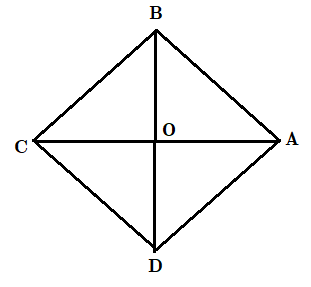
The length of the diagonals of a rhombus are $6cm$ and $8cm$ . Find the length of each side of the rhombus.
(a) $2cm$
(b) $3cm$
(c) $4cm$
(d) $5cm$
Answer
443.4k+ views
Hint: In the above question, we are given a rhombus with the length of the both diagonals. Now, we know that rhombus is a quadrilateral which has all the sides equal and the opposite angles are equal. Now, we know that the radius is half of diameter. We will use this to find the lengths of some sides. Later we will use the pythagoras theorem to find the length of the sides.
Complete step-by-step solution:
Now, the given figure denotes the rhombus

So,\[AC=8cm\] and \[BD=6cm\]
Now, we know that the diagonals of rhombus divide each other in two equal halves.
Hence, \[AO=4cm\] and \[OD=6cm\]
Now, we know that diagonals of rhombus bisect each other perpendicularly.
So, we can say that \[\angle AOD=90{}^\circ \]
In right \[\Delta AOD\] ,
We know that, \[AO=4cm\] and \[OD=3cm\]
So, by using the Pythagoras Theorem,
$\Rightarrow A{{D}^{2}}=A{{O}^{2}}+O{{D}^{2}}$
$\Rightarrow A{{D}^{2}}={{\left( 4 \right)}^{2}}+{{\left( 3 \right)}^{2}}$
$\Rightarrow AD=5cm$
So, \[AD\] is \[5cm\]
So, the sides of the rhombus are of length \[5cm\]
Hence, the correct option is \[d\].
Note: Remember the properties of Rhombus:
All sides of the rhombus are equal.
The opposite sides of rhombus are parallel.
Opposite angles of rhombus are equal.
In a rhombus, diagonals bisect each other at right angles.
Diagonals bisect the angles of a rhombus.
The sum of two adjacent angles is equal to \[180\] degrees.
Diagonals of rhombus divide each other in two equal halves.
Complete step-by-step solution:
Now, the given figure denotes the rhombus

So,\[AC=8cm\] and \[BD=6cm\]
Now, we know that the diagonals of rhombus divide each other in two equal halves.
Hence, \[AO=4cm\] and \[OD=6cm\]
Now, we know that diagonals of rhombus bisect each other perpendicularly.
So, we can say that \[\angle AOD=90{}^\circ \]
In right \[\Delta AOD\] ,
We know that, \[AO=4cm\] and \[OD=3cm\]
So, by using the Pythagoras Theorem,
$\Rightarrow A{{D}^{2}}=A{{O}^{2}}+O{{D}^{2}}$
$\Rightarrow A{{D}^{2}}={{\left( 4 \right)}^{2}}+{{\left( 3 \right)}^{2}}$
$\Rightarrow AD=5cm$
So, \[AD\] is \[5cm\]
So, the sides of the rhombus are of length \[5cm\]
Hence, the correct option is \[d\].
Note: Remember the properties of Rhombus:
All sides of the rhombus are equal.
The opposite sides of rhombus are parallel.
Opposite angles of rhombus are equal.
In a rhombus, diagonals bisect each other at right angles.
Diagonals bisect the angles of a rhombus.
The sum of two adjacent angles is equal to \[180\] degrees.
Diagonals of rhombus divide each other in two equal halves.
Recently Updated Pages
Master Class 9 General Knowledge: Engaging Questions & Answers for Success

Master Class 9 English: Engaging Questions & Answers for Success

Master Class 9 Science: Engaging Questions & Answers for Success

Master Class 9 Social Science: Engaging Questions & Answers for Success

Master Class 9 Maths: Engaging Questions & Answers for Success

Class 9 Question and Answer - Your Ultimate Solutions Guide

Trending doubts
Fill the blanks with the suitable prepositions 1 The class 9 english CBSE

How do you graph the function fx 4x class 9 maths CBSE

Name the states which share their boundary with Indias class 9 social science CBSE

Difference Between Plant Cell and Animal Cell

What is pollution? How many types of pollution? Define it

What is the color of ferrous sulphate crystals? How does this color change after heating? Name the products formed on strongly heating ferrous sulphate crystals. What type of chemical reaction occurs in this type of change.




